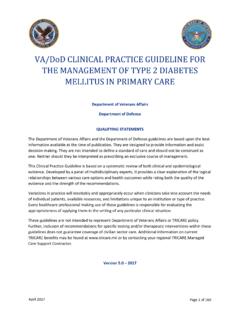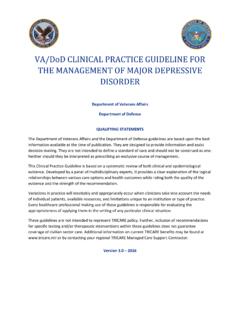Transcription of WHS Clinical Practice Guidelines/Recommendations for ...
1 WHS Clinical Practice Guidelines/Recommendations for Anticoagulation and Antiplatelet Discontinuation Prior to Surgery The following recommendations are collated from available product references, Clinical Practice guidelines , and available pharmacokinetic data and are meant for informational purposes only. Individual patient risk factors (procedural bleeding risk, peri-procedural thromboembolic risk, etc.) should be considered when decisions are made regarding discontinuation of antithrombotic agents prior to a procedure/surgery. Bleeding Risk Surgery/Procedure Type High Left atrial appendage occlusion (Watchman device) Valve repair/replacement (TAVR or open surgery) Major elective lower extremity surgery, THA (total hip), TKA (total knee)
2 Or revision of either procedure Spinal surgery Lumbar Puncture Corrective jaw or facial surgery Mastectomy PEG placement Prostate procedures ERCP Diagnostic Endoscopy/Colonoscopy including mucosal biopsy Moderate PCI VATS procedure Bronchoscopy w/biopsy Low Ablation Right Heart Catheterization Bronchoscopy w/BAL (Bronchoalveolar lavage) Thoracentesis FNA (fine needle aspiration) breast Breast biopsy (core needle biopsy) Tunneled hemodialysis catheter exchange/removal Ureteral stenting Transurethral instrumentation (cystoscopy, catheter placement) ICD or pacemaker placement No Risk to Very Low Risk *Do not hold anticoagulation/ antiplatelet Cataract surgery Dental procedures o Dental hygiene o Simple extractions o Restorations o Endodontics o Prosthetics Cutaneous surgeries Periprocedural Risk for Thromboembolism Risk High.
3 Periprocedural Anticoagulation Advised Mechanical Heart Valve Any mechanical mitral valve Older mechanical valve model (caged ball or tilting disc) in mitral or aortic position Recently placed mechanical valve (< 3 months) in mitral or aortic position Recent Stroke or TIA (within 6 months) with mitral or aortic valve Atrial Fibrillation With mechanical heart valve in mitral or aortic position With recent stroke or TIA (within 3 months) Venous Thromboembolism VTE within previous 3 months Anticoagulant Discontinuation Recommendations Apixaban(Eliquis) Renal Function (Est CrCl) Apixaban Discontinuation Plan >30ml/min Low Bleeding Risk Moderate-High Bleeding Risk Stop 24 hours before surgical procedure Stop 48 hours before surgical procedure <30ml/min Stop 36-48 hours before surgical procedure Stop 72 hours before surgical procedure *Neuraxial procedure planned Hold 72 hours prior to procedure Dabigatran (Pradaxa) Renal Function (Est CrCl)
4 Dabigatran Discontinuation Plan >50ml/min Low Bleeding Risk Moderate-High Bleeding Risk Stop 24-36 hours before surgical procedure Stop 48-72 hours before surgical procedure <50ml/min Stop 48-72 hours before surgical procedure Stop 96-120 hours before surgical procedure *Neuraxial procedure planned Est CrCl >= 80 ml/min 72 hrs before procedure 50-79 ml/min 96 hrs before procedure 30-49 ml/min 120 hrs before procedure <30ml/min Neuraxial procedure inappropriate Rivaroxaban (Xarelto) Renal Function (Est CrCl) Rivaroxaban Discontinuation Plan >30ml/min Low Bleeding Risk Moderate-High Bleeding Risk Stop 24 hours before surgical procedure Stop 48 hours before surgical procedure <30ml/min Stop 48 hours before surgical procedure Stop 72 hours before surgical procedure *Neuraxial procedure planned Hold 72 hours prior to procedure Edoxaban (Savaysa) Renal Function (Est CrCl)
5 Edoxaban Discontinuation Plan >30ml/min Low Bleeding Risk Moderate-High Bleeding Risk Stop 24 hours before surgical procedure Stop 48 hours before surgical procedure <30ml/min Stop 36 -48 hours before surgical procedure Stop 72 hours before surgical procedure *Neuraxial procedure planned Hold 72 hours prior to procedure Warfarin Pre-procedure INR Pre-Procedure Plan Stop 5 days before procedure Stop 6 days before procedure > Stop 6-7 days before procedure Consider rechecking INR after 2-3 days of held doses If indicated consider phytonadione Enoxaparin (Lovenox) Lovenox Discontinuation Plan In patients who are receiving bridge Last preoperative dose approximately 24 hours before surgery Lovenox Resumption 24 hours in patients undergoing low-risk bleeding 48-72 hours in patient undergoing high-bleeding risk surgery IV Unfractionated Heparin (UFH) IV UFH Discontinuation Plan In patients who are receiving bridge 4-6 hours before surgery Resuming Anticoagulation (VKA/Warfarin): Warfarin Complete hemostasis achieved, no catastrophic bleed location (intracranial, intraspinal) No Consider delaying initiation of anticoagulation.
6 Use Clinical judgement Yes Plan to bridge? No Start warfarin within 24 hours Yes Post procedural bleed risk? High Start warfarin within 24 hours, restart bridge within 48-72 hours Low Restart warfarin and bridge within 24 hours Journal of the American College of Cardiology1 Resuming Anticoagulation (DOAC): DOAC Complete hemostasis achieved, no catastrophic bleed location (intracranial, intraspinal) Yes Can the patient tolerate oral medications? Yes Postprocedural bleed risk High Reinitiate DOAC within 48-72 hours following procedure Low Reinitiate DOAC within 24 hours. Consider reduced dose evening following procedure No Postprocedural bleed risk High Parenteral anticoagulation within 48-72 hours Low Parenteral anticoagulation within 24 hours No Consider delaying reinitiation of anticoagulation; use Clinical judgement Journal of the American College of Cardiology1 Noncardiac Surgery Recommendations for Patients on Dual Antiplatelet Therapy for Percutaneous Intervention Low Risk Intermediate Risk High Risk Low Risk Continue ASA and discontinue P2Y12 receptor inhibitor.
7 Resume within 24-72 hours Continue ASA and discontinue P2Y12 receptor inhibitor; resume within 24-72 hours Continue ASA and discontinue P2Y12 receptor inhibitor; resume within 24-72 hours Intermediate Risk Continue ASA and discontinue P2Y12 receptor inhibitor; resume within 24-72 hours Continue ASA and discontinue P2Y12 receptor inhibitor; resume within 24-72 hours Continue ASA; discontinue P2Y12 receptor inhibitor; resume within 24 72 hours High Risk Postpone Elective Surgery If surgery cannot be deferred, continue ASA and P2Y12 receptor inhibitor perioperatively. Postpone Elective Surgery If surgery nondeferrable: continue ASA; discontinue P2Y12 receptor inhibitor; resume within 24 72 hours Postpone Elective Surgery If surgery nondeferrable: continue ASA; discontinue P2Y12 receptor inhibitor; resume within 24 72 hours 5.
8 Banerjee, S., Angiolillo, D. J., Boden, W. E., Murphy, J. G., Khalili, H., Hasan, A. A., .. Rao, S. V. (2017). Use of Antiplatelet Therapy/DAPT for Post-PCI Patients Undergoing Noncardiac Surgery. Journal of the American College of Cardiology, 69(14), 1861-1870. **When indicated, recommendation is to hold P2Y12 inhibitors: Clopidogrel(Plavix): 5-7 days, Prasugrel(Effient): 7-10 days, Ticagrelor(Brillinta): 5-7 days, Ticlodipine(Ticlid): 10 days Thrombotic Risk Hemorrhagic Risk APT = antiplatelet therapy; ASA = aspirin; IV = intravenous Determination of Thrombotic Risk Low Risk (<1%)* Intermediate Risk (1-5%)* High Risk (>5%)* >4 weeks after PCI with POBA >2 weeks and </=4 weeks after PCI with POBA </=2 weeks after PCI with POBA >6 months after PCI with BMS >1 month and </=6 months after PCI with BMS </=1 month after PCI with BMS >12 months after PCI with DES >6 months and </=12 months after PCI with DES </=6 months after PCI with DES >12 months after complex PCI with DES (long stents, multiple stents, overlapping, small vessels, bifurcations, left main, last remaining vessel)
9 </=12 months after complex PCI with DES </=6 months after PCI for MI Previous ST *30 day ischemic event rates of cardiovascular death and MI BMS = bare metal stent(s), DES = drug eluding sent(s), MI = myocardial infarction, PCI = percutaneous coronary intervention, POBA = plain old balloon angioplasty, ST = stent thrombosis 5. Banerjee, S., Angiolillo, D. J., Boden, W. E., Murphy, J. G., Khalili, H., Hasan, A. A., .. Rao, S. V. (2017). Use of Antiplatelet Therapy/DAPT for Post-PCI Patients Undergoing Noncardiac Surgery. Journal of the American College of Cardiology, 69(14), 1861-1870.
10 1. Doherty, J. U., Gluckman, T. J., Hucker, W. J., Januzzi, J. L., Ortel, T. L., Saxonhouse, S. J., & Spinler, S. A. (2017). 2017 ACC Expert Consensus Decision Pathway for Periprocedural Management of Anticoagulation in Patients With Nonvalvular Atrial Fibrillation. Journal of the American College of Cardiology, 69(7), 871-898. 2. Douketis JD, Spyropoulos AC, Spencer FA, et al. Perioperative management of antithrombotic therapy: Antithrombotic thera


